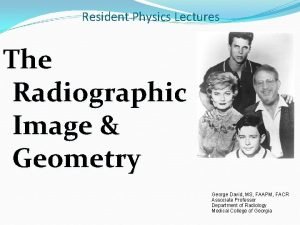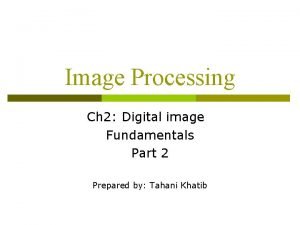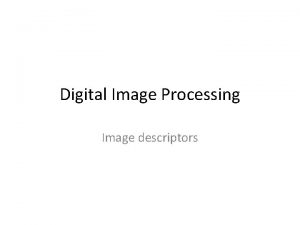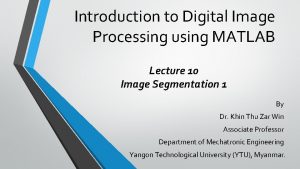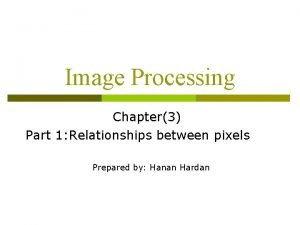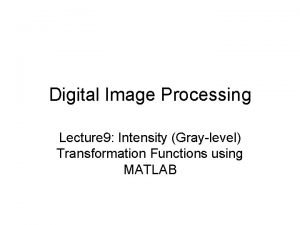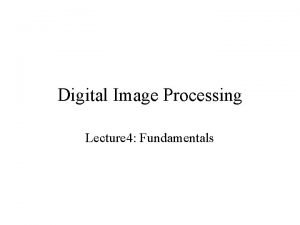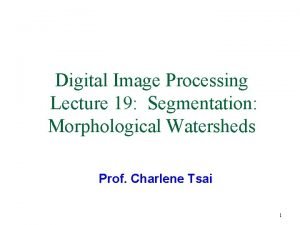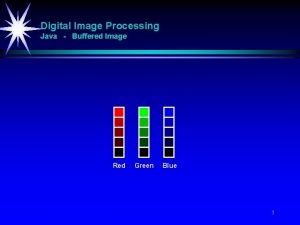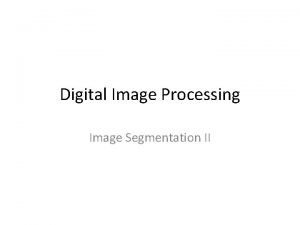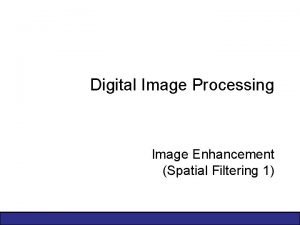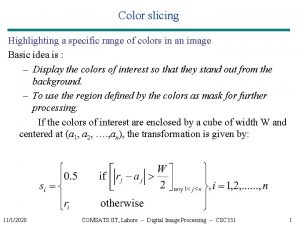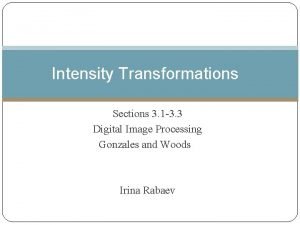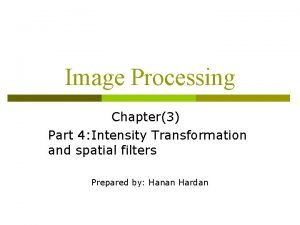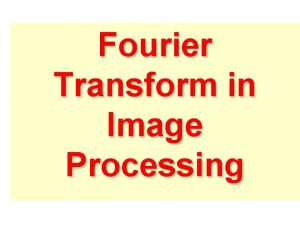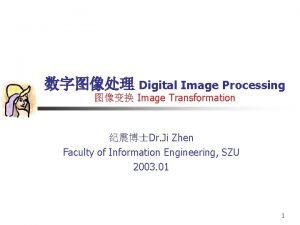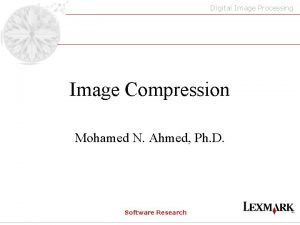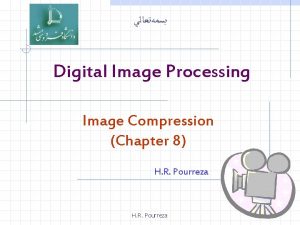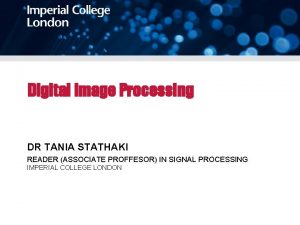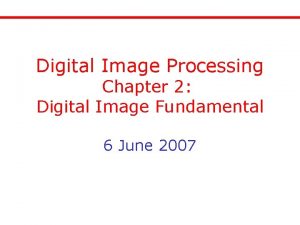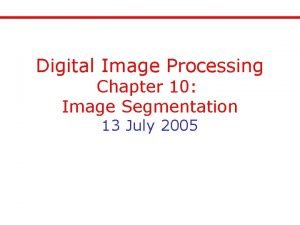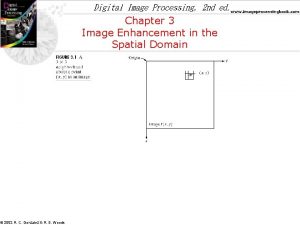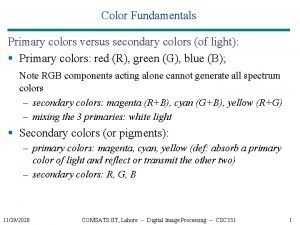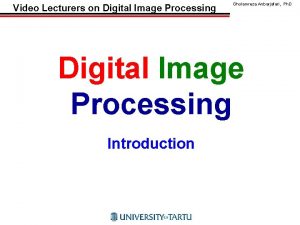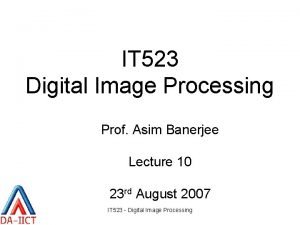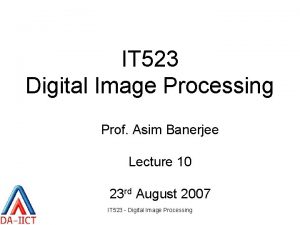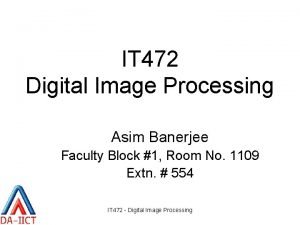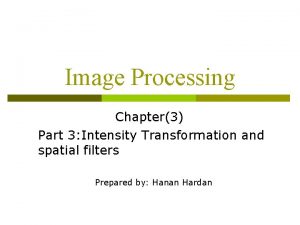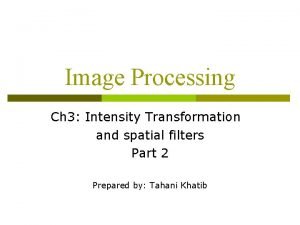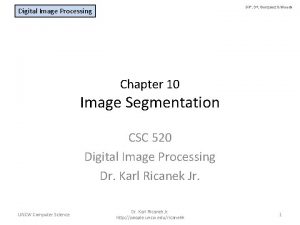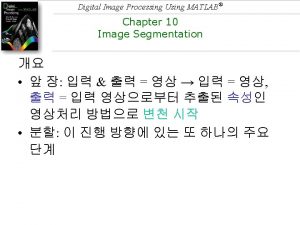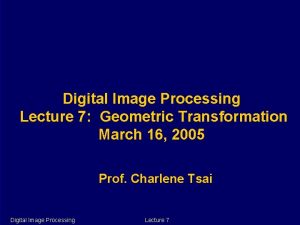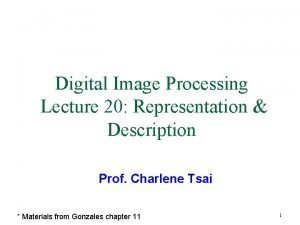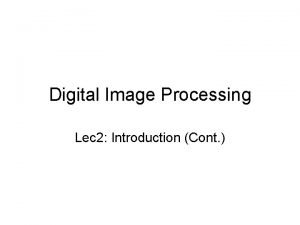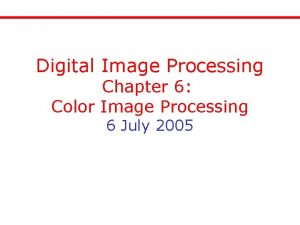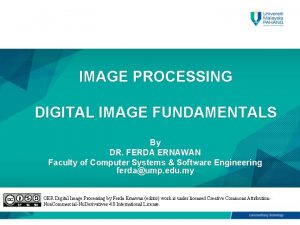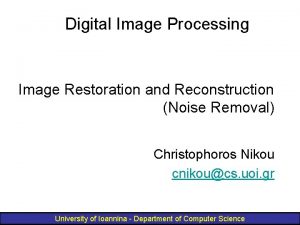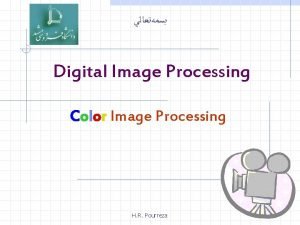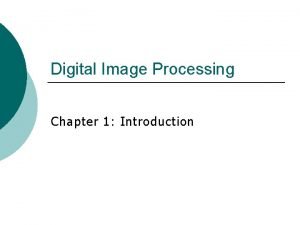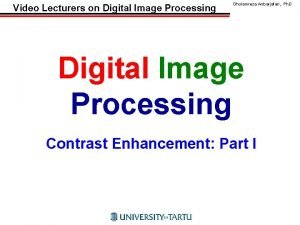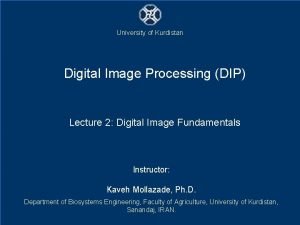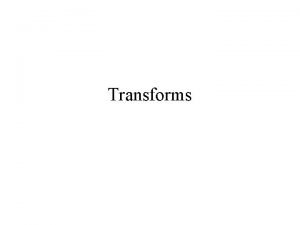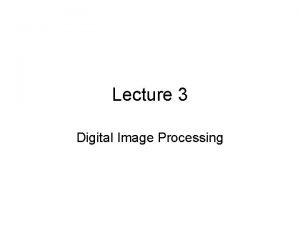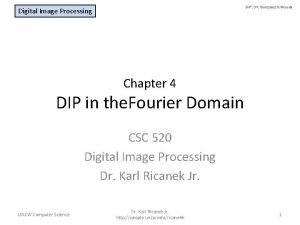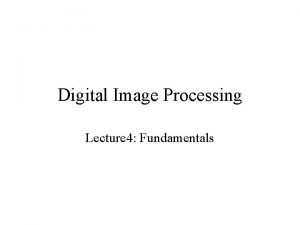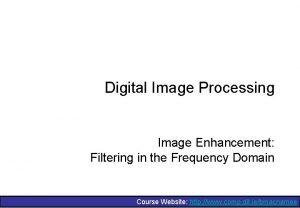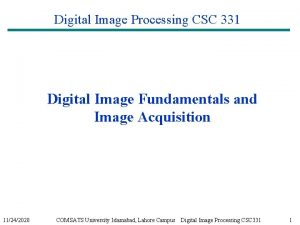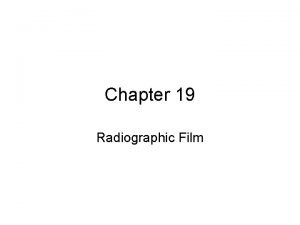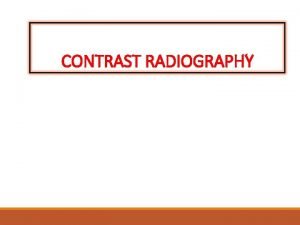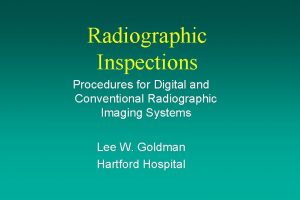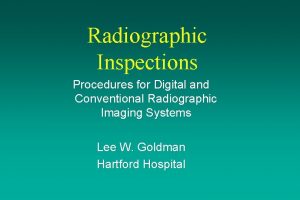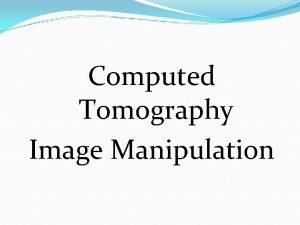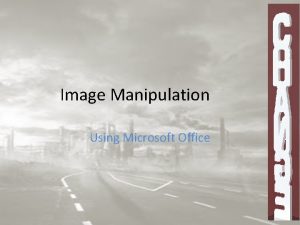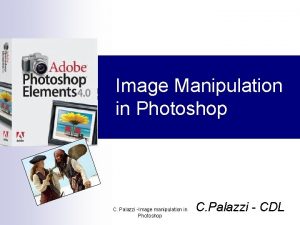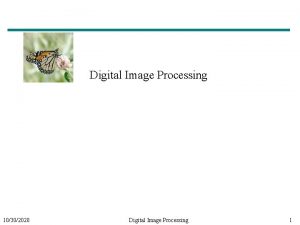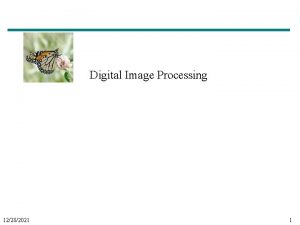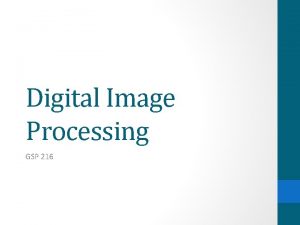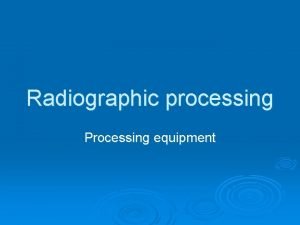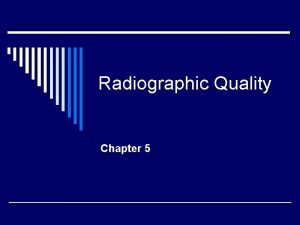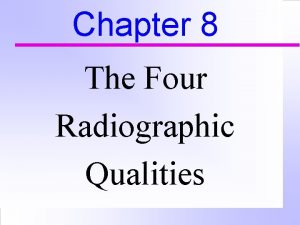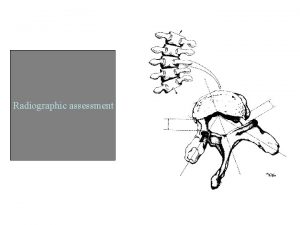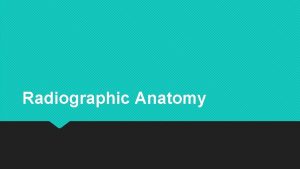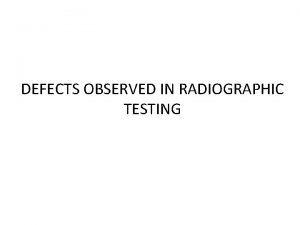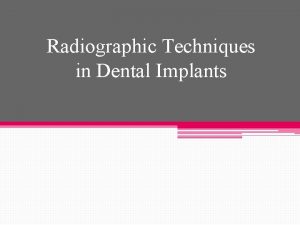Chapter 7 Digital Radiographic Image Processing and Manipulation

















































































- Slides: 81

Chapter 7 Digital Radiographic Image Processing and Manipulation Elsevier items and derived items © 2008 by Mosby, Inc. , an affiliate of Elsevier Inc. 1

Objectives Describe formation of an image histogram. Discuss automatic rescaling. Compare image latitude in digital imaging with film/screen radiography. List the functions of contrast enhancement parameters. State the Nyquist theorem. Elsevier items and derived items © 2008 by Mosby, Inc. , an affiliate of Elsevier Inc. 2

Objectives Describe the effects of improper algorithm application. Explain modulation transfer function. Discuss the purpose and function of image manipulation factors. Describe the major factors in image management. Elsevier items and derived items © 2008 by Mosby, Inc. , an affiliate of Elsevier Inc. 3

Key Terms Archive query Automatic rescaling Contrast manipulation Edge enhancement High-pass filtering Histogram Image annotation Image orientation Image sampling Image stitching Latitude Elsevier items and derived items © 2008 by Mosby, Inc. , an affiliate of Elsevier Inc. 4

Key Terms Look-up table Low-pass filtering Magnification Manual send Modulation transfer function Nyquist theorem Patient demographics Shutter Smoothing Spatial frequency resolution Window and level Elsevier items and derived items © 2008 by Mosby, Inc. , an affiliate of Elsevier Inc. 5

Digital Radiographic Image Processing and Manipulation In cassette-based and cassetteless systems, once the x-ray photons have been converted into electrical signals, these signals are available for processing and manipulation. The reader is used only for cassette-based systems, but the processing parameters and image manipulation controls are similar for both systems. Elsevier items and derived items © 2008 by Mosby, Inc. , an affiliate of Elsevier Inc. 6

Preprocessing Preprocessing takes place in the computer where the algorithms determine the image histogram. Postprocessing is done by the technologist through various user functions. Digital preprocessing methods are vendor-specific. Elsevier items and derived items © 2008 by Mosby, Inc. , an affiliate of Elsevier Inc. 7

CR Reader Functions The computed radiography (CR) imaging plate records a wide range of x-ray exposures. If the entire range of exposure were digitized, values at extremely high and low ends of range would also be digitized. This would result in low-density resolution. To avoid this, exposure data recognition processes only the optimal density exposure range. Elsevier items and derived items © 2008 by Mosby, Inc. , an affiliate of Elsevier Inc. 8

CR Reader Functions Data recognition program searches for anatomy recorded on the imaging plate as follows: Finding collimation edges • Eliminating scatter outside the collimation • Failure of the system to find the collimation edges can result in incorrect data collection. Images may be too bright or too dark. Elsevier items and derived items © 2008 by Mosby, Inc. , an affiliate of Elsevier Inc. 9

CR Reader Functions Data within collimation result in generation of a graphic representation called a histogram. Because information within the collimated area is signal used for image data, the information is the source for a vendor-specific exposure data indicator. Elsevier items and derived items © 2008 by Mosby, Inc. , an affiliate of Elsevier Inc. 10

CR Image Sampling Plate is scanned. Image location and orientation is determined. Size of the signal is determined. Value is placed on each pixel. Elsevier items and derived items © 2008 by Mosby, Inc. , an affiliate of Elsevier Inc. 11

CR Image Sampling Histogram is generated that allows system to find useful signal by locating the minimum (S 1) and maximum (S 2) signal within the anatomic regions of interest in the image. Histogram identifies all densities on the imaging plate in the form of a graph: X-axis is related to amount of exposure. • Y-axis displays the number of pixels for each exposure. • Graphic representation appears as a series of peaks and valleys and has a pattern that varies for each body part. • Elsevier items and derived items © 2008 by Mosby, Inc. , an affiliate of Elsevier Inc. 12

CR Image Sampling Low energy (kilovoltage peak) gives a wider histogram. High energy (kilovoltage peak) gives a narrow histogram. Histogram shows the distribution of pixel values for any given exposure. Elsevier items and derived items © 2008 by Mosby, Inc. , an affiliate of Elsevier Inc. 13

CR Image Sampling For example: Pixels have a value of 1, 2, 3, and 4 for a specific exposure. • Histogram shows the frequency of each of those values and actual number of values. • Histogram sets the minimum (S 1) and maximum (S 2) “useful” pixel values. • Elsevier items and derived items © 2008 by Mosby, Inc. , an affiliate of Elsevier Inc. 14

Histogram Analysis is complex. Shape of the histogram stays fairly constant for each part exposed (anatomy specific). For example: • Shape of histogram for a chest radiograph on a large adult patient looks different from a knee histogram generated from a pediatric knee exam. Elsevier items and derived items © 2008 by Mosby, Inc. , an affiliate of Elsevier Inc. 15

Histogram Analysis It is important to choose the correct anatomic region on the menu before exposing the patient. Raw data used to form the histogram are compared with a “normal” histogram of the same body part by the computer. Elsevier items and derived items © 2008 by Mosby, Inc. , an affiliate of Elsevier Inc. 16

The Nyquist Theorem states that when sampling a signal, the sampling frequency must be greater than twice the bandwidth of the input signal so that the reconstruction of the original image will be nearly perfect. At least twice the number of pixels needed to form the image must be sampled. If too few pixels are sampled, the result is a lack of resolution. Elsevier items and derived items © 2008 by Mosby, Inc. , an affiliate of Elsevier Inc. 17

The Nyquist Theorem The number of conversions in CR—electron to light, light to digital information, digital to analog signal— results in loss of detail. Some light is lost during the light-to-digital conversion because of the spreading out of light photons. Because there is a small distance between the phosphor plate surface and the photosensitive diode of the photomultiplier, some light spreads out there as well, resulting in loss of information. Elsevier items and derived items © 2008 by Mosby, Inc. , an affiliate of Elsevier Inc. 18

The Nyquist Theorem The longer the electrons are stored, the more energy they lose. When laser stimulates electrons, some lower-energy electrons escape the active layer. If enough energy was lost, some lower-energy electrons are not stimulated enough to escape and information is lost. All manufacturers suggest that imaging plates be read as soon as possible to avoid this loss. Elsevier items and derived items © 2008 by Mosby, Inc. , an affiliate of Elsevier Inc. 19

The Nyquist Theorem Indirect and direct radiography lose less signal to light spread than conventional radiography. The Nyquist theorem is still applied to ensure that sufficient signal is sampled. Because sample is preprocessed by the computer immediately, signal loss is minimized but still occurs. Elsevier items and derived items © 2008 by Mosby, Inc. , an affiliate of Elsevier Inc. 20

Aliasing Spatial frequency is greater than the Nyquist frequency. Sampling occurs less than twice per cycle. Information is lost. Fluctuating signal is produced. Elsevier items and derived items © 2008 by Mosby, Inc. , an affiliate of Elsevier Inc. 21

Aliasing Wraparound image is produced. Image appears as two superimposed images slightly out of alignment. Aliasing results in a moiré effect. Aliasing can be problematic because of the same effect occurring with grid errors. It is important that the technologist remembers to look at both. Elsevier items and derived items © 2008 by Mosby, Inc. , an affiliate of Elsevier Inc. 22

Automatic Rescaling Exposure is greater than or less than what is needed to produce an image. Automatic rescaling occurs to display the pixels for the area of interest. Images are produced that have uniform density and contrast regardless of the amount of exposure. Elsevier items and derived items © 2008 by Mosby, Inc. , an affiliate of Elsevier Inc. 23

Automatic Rescaling Problems occur with rescaling: When too little exposure is used, resulting in quantum mottle • When too much exposure is used, resulting in loss of contrast and loss of distinct edges because of increased scatter production • Rescaling is no substitute for appropriate technical factors. Danger exists of using higher than necessary milliampere-second values to avoid quantum mottle. Elsevier items and derived items © 2008 by Mosby, Inc. , an affiliate of Elsevier Inc. 24

Look-Up Table The look-up table (LUT) is a reference histogram. LUT is used as a cross-reference to transform the raw information. LUT is used to correct values. LUT has a mapping function: • All pixels are changed to a new gray value. Image will have appropriate appearance in brightness and contrast. LUT is provided for every anatomic part. Elsevier items and derived items © 2008 by Mosby, Inc. , an affiliate of Elsevier Inc. 25

Look-Up Table LUT can be graphed as follows: Plotting the original values ranging from 0 to 255 on the horizontal axis • Plotting new values, also ranging from 0 to 255 on the vertical axis • Contrast can be increased or decreased by changing the slope of this graph. Brightness (density) can be increased or decreased by moving the line up or down the y-axis. Elsevier items and derived items © 2008 by Mosby, Inc. , an affiliate of Elsevier Inc. 26

Latitude Latitude is the amount of error that still results in a quality image. Histograms show a wide range of exposure because of automatic rescaling of the pixels. Actual exposure latitude is slightly greater than that of screen/film exposures. In CR, if exposure is more than 50% below ideal exposure, quantum mottle results. Elsevier items and derived items © 2008 by Mosby, Inc. , an affiliate of Elsevier Inc. 27

Latitude If exposure is more than 200% above ideal exposure, contrast loss results. Biggest difference between digital and film/screen radiography lies in the ability to manipulate the digitized pixel values, which results in what seems like greater exposure latitude. Proper kilovolt and milliampere-second values prevent mottle and contrast loss. Elsevier items and derived items © 2008 by Mosby, Inc. , an affiliate of Elsevier Inc. 28

Enhanced Visualization Image Processing Kodak Takes image diagnostic quality to a new level Increases latitude while preserving contrast Process decreases windowing and leveling Virtually eliminates detail loss in dense tissues Elsevier items and derived items © 2008 by Mosby, Inc. , an affiliate of Elsevier Inc. 29

Modulation Transfer Function Modulation transfer function (MTF) is the ability of a system to record available spatial frequencies. Sum of the components in a recording system cannot be greater than the system as a whole. When the function of any component is compromised because of interference, the overall quality of the system is affected. Elsevier items and derived items © 2008 by Mosby, Inc. , an affiliate of Elsevier Inc. 30

Modulation Transfer Function MTF is a way to quantify the contribution of each system component to the overall efficiency of the entire system—e. g. , ratio of the image to the object. A perfect system would have an MTF of 1 or 100%. Elsevier items and derived items © 2008 by Mosby, Inc. , an affiliate of Elsevier Inc. 31

Modulation Transfer Function Digital detectors • • • X-ray photon energy excites a phosphor. Phosphor produces light. Spreading out of the light will always occur. Light spread reduces system efficiency. The more light spread, the lower the MTF. Elsevier items and derived items © 2008 by Mosby, Inc. , an affiliate of Elsevier Inc. 32

Quality Control Workstation Functions Image processing parameters Contrast manipulation Spatial frequency resolution Spatial frequency filtering Elsevier items and derived items © 2008 by Mosby, Inc. , an affiliate of Elsevier Inc. 33

Image Processing Parameters Digital systems have greater dynamic range than film/screen imaging. Initial digital image appears linear when graphed because all shades of gray are visible. Digitalization gives the image a wide latitude. If all shades were left in the image, contrast would be too low. Elsevier items and derived items © 2008 by Mosby, Inc. , an affiliate of Elsevier Inc. 34

Image Processing Parameters To avoid this, digital systems make use of various contrast-enhancement parameters. Names differ by vendor; Agfa uses MUSICA, Fuji uses Gradation, and Kodak uses Tonescaling. Purpose and effects are basically the same. Elsevier items and derived items © 2008 by Mosby, Inc. , an affiliate of Elsevier Inc. 35

Contrast Manipulation Contrast-enhancement parameters convert the digital input data to an image with appropriate density and contrast. Image contrast is controlled by using a parameter that changes the steepness of the exposure gradient. Elsevier items and derived items © 2008 by Mosby, Inc. , an affiliate of Elsevier Inc. 36

Contrast Manipulation Density can be varied at the toe and shoulder of the curve, removing the extremely low and extremely high density values using a different parameter. Another parameter allows density to remain unchanged while contrast is varied. These parameters should be used to enhance the image only; no amount of adjustment takes the place of proper technical factor selection. Elsevier items and derived items © 2008 by Mosby, Inc. , an affiliate of Elsevier Inc. 37

Workstation Screen Showing Contrast Manipulation Choices Elsevier items and derived items © 2008 by Mosby, Inc. , an affiliate of Elsevier Inc. 38

Spatial Frequency Resolution Sharpness control is referred to as spatial frequency processing. Sharpness is controlled in film/screen by various factors such as focal spot size, screen and/or film speed, and object image distance. Digitized images can be further controlled for sharpness. Elsevier items and derived items © 2008 by Mosby, Inc. , an affiliate of Elsevier Inc. 39

Spatial Frequency Resolution Controls are available for the following: Structure to be enhanced • Degree of enhancement for each density to reduce image graininess • How much edge enhancement is applied • If improper algorithms are applied, image formation is affected. It is possible to degrade image information if algorithms are improperly applied. Elsevier items and derived items © 2008 by Mosby, Inc. , an affiliate of Elsevier Inc. 40

Spatial Frequency Filtering Edge enhancement Smoothing Elsevier items and derived items © 2008 by Mosby, Inc. , an affiliate of Elsevier Inc. 41

Edge Enhancement When the signal is obtained, averaging of the signal occurs to shorten processing time and storage. The more pixels involved in the averaging, the smoother the image appears. Signal strength of one pixel is averaged with the strength of adjacent pixels or neighborhood pixels. Elsevier items and derived items © 2008 by Mosby, Inc. , an affiliate of Elsevier Inc. 42

Edge Enhancement Edge enhancement occurs when fewer pixels in the neighborhood are included in the signal average. The smaller the neighborhood, the greater the enhancement. When frequencies of areas of interest are known, they can be amplified and other frequencies can be suppressed. Elsevier items and derived items © 2008 by Mosby, Inc. , an affiliate of Elsevier Inc. 43

Edge Enhancement Amplification, also known as high-pass filtering, results in an increase of contrast and edge enhancement. • Suppression of frequencies, also known as masking, can result in loss of small details. • This technique is useful for enhancing large structures such as organs and soft tissues but can be noisy. • Elsevier items and derived items © 2008 by Mosby, Inc. , an affiliate of Elsevier Inc. 44

Smoothing Smoothing is another type of spatial frequency filtering. Smoothing is also known as low-pass filtering. Smoothing results from averaging of the frequency of each pixel with surrounding pixel values to remove high-frequency noise. Result is a reduction of noise and contrast. Low-pass filtering is useful for viewing small structures such as fine bone tissues. Elsevier items and derived items © 2008 by Mosby, Inc. , an affiliate of Elsevier Inc. 45

Basic Functions of the Processing System Image manipulation Image management Elsevier items and derived items © 2008 by Mosby, Inc. , an affiliate of Elsevier Inc. 46

Image Manipulation Window and level Background removal or shutter Image orientation Image stitching Image annotation Magnification Elsevier items and derived items © 2008 by Mosby, Inc. , an affiliate of Elsevier Inc. 47

Window and Level Window and level are the most common controls for brightness and contrast. Window controls how light or dark the image is. Level controls the ratio of black to white, or contrast. User is able to manipulate quickly through use of the mouse. Elsevier items and derived items © 2008 by Mosby, Inc. , an affiliate of Elsevier Inc. 48

Window and Level One direction, vertical or horizontal, controls brightness, and the other direction, contrast. To control density and contrast further, contrast enhancement parameters are used. Elsevier items and derived items © 2008 by Mosby, Inc. , an affiliate of Elsevier Inc. 49

Background Removal or Shutter Unexposed borders around the collimation edges allow excess light to enter the eye. Effect is known as veil glare. Glare causes oversensitization of a chemical within the eye called rhodopsin. This results in temporary white light blindness. Elsevier items and derived items © 2008 by Mosby, Inc. , an affiliate of Elsevier Inc. 50

Background Removal or Shutter Eye recovers quickly enough so that viewer recognizes only that the light is very bright. Glare is a great distraction that interferes with image reception by the eye. In film/screen radiography, black cardboard glare masks or special automatic collimation view boxes were used to lessen the effects of veil glare, but no techniques were entirely successful or convenient. Elsevier items and derived items © 2008 by Mosby, Inc. , an affiliate of Elsevier Inc. 51

Background Removal or Shutter In CR, automatic shuttering is used to blacken out the white collimation borders. This eliminates veil glare. Shuttering is a viewing technique only. Shuttering should never be used to mask poor collimation practices. Elsevier items and derived items © 2008 by Mosby, Inc. , an affiliate of Elsevier Inc. 52

Background Removal or Shutter Removal of the white unexposed borders results in an overall smaller number of pixels. This reduces the amount of information to be stored. Elsevier items and derived items © 2008 by Mosby, Inc. , an affiliate of Elsevier Inc. 53

Image Orientation Image reader scans and reads the image from the leading edge of the imaging plate to the opposite end. Image is displayed exactly as it was read. Different vendors mark the cassettes in different ways. Cassette must be oriented so that the image is processed to display as expected. Elsevier items and derived items © 2008 by Mosby, Inc. , an affiliate of Elsevier Inc. 54

Image Orientation Fuji uses a tape-type orientation marker. Kodak uses a sticker. Some exams require unusual orientation of the cassette. Reader must be informed of the orientation of the anatomy with respect to the reader. In digital radiography, the position of the part should correspond with the marked top and sides of the imaging plate. Elsevier items and derived items © 2008 by Mosby, Inc. , an affiliate of Elsevier Inc. 55

Image Stitching is used for anatomy or areas of interest too large to fit on one cassette. Multiple images can be “stitched” together. Sometimes, special cassette holders are used and positioned vertically, corresponding to foot to hip or entire spine radiography. Elsevier items and derived items © 2008 by Mosby, Inc. , an affiliate of Elsevier Inc. 56

Image Stitching Images are processed in computer programs that nearly seamlessly join the anatomy. Computer displays one single image. Process eliminates the need for large (36 -inch) cassettes previously used in film/screen radiography. Elsevier items and derived items © 2008 by Mosby, Inc. , an affiliate of Elsevier Inc. 57

Image Annotation Information other than standard identification must be added to the image. In screen/film radiography, additional information is marked by the following: Time and date stickers • Grease pencils • Permanent markers • Elsevier items and derived items © 2008 by Mosby, Inc. , an affiliate of Elsevier Inc. 58

Image Annotation Annotation function allows selection of preset terms and/or manual text input. Annotation can be useful when such additional information is necessary. Annotations overlay the image as bitmap images. Annotations may not transfer to picture archival and communication system (PACS). Input of annotation for identification of the patient’s left or right side should never be used as a substitute for technologist’s anatomy markers. Elsevier items and derived items © 2008 by Mosby, Inc. , an affiliate of Elsevier Inc. 59

Magnification Two basic types of magnification techniques are standard with digital systems: • One type functions as a magnifying glass: • A box is placed over a small segment of anatomy on the main image. • Box shows a magnified version of the underlying anatomy. • The size of the magnified area and the amount of magnification can be made larger or smaller. Elsevier items and derived items © 2008 by Mosby, Inc. , an affiliate of Elsevier Inc. 60

Magnification Other technique is “zoom. ” • Zoom allows magnification of the entire image. • Image can be enlarged enough that only parts of it are visible on the screen. • Those parts can be seen through mouse navigation. • Elsevier items and derived items © 2008 by Mosby, Inc. , an affiliate of Elsevier Inc. 61

Image Management Patient demographics input Manual send Archive query Elsevier items and derived items © 2008 by Mosby, Inc. , an affiliate of Elsevier Inc. 62

Patient Demographics Input Proper identification of the patient is even more critical. Retrieval can be nearly impossible if image is not properly and accurately identified. Elsevier items and derived items © 2008 by Mosby, Inc. , an affiliate of Elsevier Inc. 63

Patient Demographics Input Demographic information about the patient includes the following: • • Name Health care facility Patient identification number Date of birth Exam date Other pertinent information Input or linked via barcode label scans, before the start of the exam and before the processing phase Elsevier items and derived items © 2008 by Mosby, Inc. , an affiliate of Elsevier Inc. 64

Patient Demographics Input Occasionally, errors are made and demographic information must be altered. If technologist performing the exam is absolutely positive that image is of the correct patient, then demographic information can be altered at the processing stage. This function should be tracked and changes should be linked to the technologist altering the information to ensure accuracy and accountability. Elsevier items and derived items © 2008 by Mosby, Inc. , an affiliate of Elsevier Inc. 65

Patient Demographics Input Problems occur if the patient name is entered differently from visit to visit or exam to exam. For example: Patient’s name is Jane A. Doe and is entered that way. • Name must be entered that way for every other exam. • If name is entered as Jane Doe, then system will save it as a different patient. • Merging of files can be difficult. • Elsevier items and derived items © 2008 by Mosby, Inc. , an affiliate of Elsevier Inc. 66

Patient Demographics Input Problems: Several versions of the name are given. • Suppose the patient gives a middle name on one visit but has multiple exams under his or her first name. • Retrieval of previous files will be difficult. • The right images must be placed in the correct data files. • Elsevier items and derived items © 2008 by Mosby, Inc. , an affiliate of Elsevier Inc. 67

Manual Send Because the quality control workstation is networked to the PACS, it also has the capability to send images to local networkstations. The manual send function allows the quality control technologist to select one or more local computers to receive images. Elsevier items and derived items © 2008 by Mosby, Inc. , an affiliate of Elsevier Inc. 68

Archive Query PACS archive can be queried for historical images. Function allows retrieval of images from the PAC system based on the following: • • • Date of exam Patient name or number Exam number Pathologic condition Anatomic area Elsevier items and derived items © 2008 by Mosby, Inc. , an affiliate of Elsevier Inc. 69

Archive Query Example: Technologist could query PACS to retrieve all chest radiographs for a particular date or range of dates. • Technologist could query retrieval of all of a patient’s images. • Multiple combinations of query fields are possible: • • Can generate general retrieval • Specific recovery of images Elsevier items and derived items © 2008 by Mosby, Inc. , an affiliate of Elsevier Inc. 70

Summary Recognition of exposure data involves processing only the optimal density exposure range and generates a graphic representation or histogram of the optimal densities. The plate is scanned, and the image location and orientation are determined. A value is place on each pixel, and the histogram is generated displaying the minimum and maximum diagnostic signal. Elsevier items and derived items © 2008 by Mosby, Inc. , an affiliate of Elsevier Inc. 71

Summary The histogram is anatomic region specific and remains fairly constant from patient to patient. Automatic rescaling allows pixel display for the area of interest, regardless of the amount of exposure unless the exposure is too low or too high. In those cases, quantum mottle or contrast loss occurs. Elsevier items and derived items © 2008 by Mosby, Inc. , an affiliate of Elsevier Inc. 72

Summary There is no substitute for proper kilovoltage peak and milliampere-second settings. Images cannot be created from nothing; that is, insufficient photons, insufficient penetration, or overpenetration will result in loss of diagnostic information that cannot be manufactured by manipulation of the image parameters. Elsevier items and derived items © 2008 by Mosby, Inc. , an affiliate of Elsevier Inc. 73

Summary Exposure latitude is slightly greater with digital imaging than that of film/screen imaging because of the wide range of exposures recorded with digital systems. Contrast-enhancement parameters allow enhancement of the image by controlling the steepness of the exposure gradient, density variance, and contrast amount. Elsevier items and derived items © 2008 by Mosby, Inc. , an affiliate of Elsevier Inc. 74

Summary Spatial frequency resolution is controlled by focal spot, object image distance, and computer algorithms. The Nyquist theorem is applied to digital images to ensure that sufficient signal sampling occurs so that maximum resolution is achieved. MTF refers to the contribution of all system components to total resolution. The closer the MTF value is to 1, the better the resolution. Elsevier items and derived items © 2008 by Mosby, Inc. , an affiliate of Elsevier Inc. 75

Summary Edge enhancement is accomplished by limiting the number of pixels in a neighborhood of the matrix. Known area of interest frequencies can be amplified or high-pass filtered to increase contrast and edge enhancement. Suppression of frequencies of lesser importance, known as masking, can cause small detail loss. Elsevier items and derived items © 2008 by Mosby, Inc. , an affiliate of Elsevier Inc. 76

Summary Low-pass filtering or smoothing is the result of pixel averaging to remove high-frequency noise. Contrast and noise are decreased, allowing small structures to be seen. Window and level parameters control pixel brightness and contrast. Elsevier items and derived items © 2008 by Mosby, Inc. , an affiliate of Elsevier Inc. 77

Summary Shuttering is a process that removes or replaces the background in order to block distracting light surrounding a digital image. This does not take the place of proper collimation and can be removed to show proper collimation. Digital imaging cassettes are marked for orientation to the top and right sides. This ensures that images are displayed correctly. Elsevier items and derived items © 2008 by Mosby, Inc. , an affiliate of Elsevier Inc. 78

Summary Image stitching is a computer program process that allows multiple images to be joined when the anatomy is too large for one exposure. The result is a nearly seamless, single image. Magnification techniques are available with digital systems that allow small area enlargement or whole image enlargement. Elsevier items and derived items © 2008 by Mosby, Inc. , an affiliate of Elsevier Inc. 79

Summary Proper patient demographic input is the responsibility of the technologist performing the exam. Any alterations of patient demographics should be avoided unless absolute identification is possible. The manual send function allows images to be sent to one or more networked computers. Elsevier items and derived items © 2008 by Mosby, Inc. , an affiliate of Elsevier Inc. 80

Summary Historical study of patient exams can be accomplished through the archive query function. Retrieval of radiographic studies can be specific as to patient name, date, and exam or broad such as date ranges and combinations of anatomic areas. Elsevier items and derived items © 2008 by Mosby, Inc. , an affiliate of Elsevier Inc. 81
 Histogram processing in digital image processing
Histogram processing in digital image processing Neighborhood processing
Neighborhood processing Nonlinear image processing
Nonlinear image processing Image processing
Image processing Fractal
Fractal Morphological processing in digital image processing
Morphological processing in digital image processing Image transform in digital image processing
Image transform in digital image processing Optimum notch filter in image processing
Optimum notch filter in image processing Image compression in digital image processing
Image compression in digital image processing Key stages in digital image processing
Key stages in digital image processing Error free compression in digital image processing
Error free compression in digital image processing Image sharpening and restoration
Image sharpening and restoration Image geometry in digital image processing
Image geometry in digital image processing Image formation model in digital image processing ppt
Image formation model in digital image processing ppt Image transform in digital image processing
Image transform in digital image processing Maketform
Maketform Image restoration in digital image processing
Image restoration in digital image processing Radiographic quality
Radiographic quality Geometric unsharpness of margins in radiographic image:
Geometric unsharpness of margins in radiographic image: Representation and description in digital image processing
Representation and description in digital image processing Zooming and shrinking in digital image processing
Zooming and shrinking in digital image processing Representation and description in digital image processing
Representation and description in digital image processing Patterns and pattern classes in digital image processing
Patterns and pattern classes in digital image processing Analog image and digital image
Analog image and digital image Image representation and description
Image representation and description Double thresholding matlab
Double thresholding matlab Introduction to digital image processing
Introduction to digital image processing Adjacency in image processing examples
Adjacency in image processing examples Intensity transformation functions in image processing
Intensity transformation functions in image processing Gray level transformation in digital image processing
Gray level transformation in digital image processing Types of adjacency in image processing
Types of adjacency in image processing Coordinate conventions in digital image processing
Coordinate conventions in digital image processing Dam construction in image processing
Dam construction in image processing Digital image processing java
Digital image processing java Thresholding in digital image processing
Thresholding in digital image processing Filteration
Filteration Digital image processing
Digital image processing Thresholding in digital image processing
Thresholding in digital image processing Boundary representation in digital image processing
Boundary representation in digital image processing Colour slicing
Colour slicing Power law transform
Power law transform Types of spatial filtering in digital image processing
Types of spatial filtering in digital image processing Fourier transform in image processing
Fourier transform in image processing Nextpow
Nextpow Digital image processing
Digital image processing Haar transform in digital image processing for n=4
Haar transform in digital image processing for n=4 Digital image processing
Digital image processing Lossy compression in digital image processing
Lossy compression in digital image processing Digital image processing
Digital image processing What is mach band effect in digital image processing
What is mach band effect in digital image processing Image processing
Image processing Digital image processing
Digital image processing Color fundamentals in digital image processing
Color fundamentals in digital image processing Digital image processing
Digital image processing Digital path in image processing
Digital path in image processing Digital path in image processing
Digital path in image processing Lossless compression in digital image processing
Lossless compression in digital image processing Intensity level slicing in image processing
Intensity level slicing in image processing Intensity transformation in digital image processing
Intensity transformation in digital image processing Digital image processing
Digital image processing Digital image processing
Digital image processing Euclidean transformation in digital image processing
Euclidean transformation in digital image processing For a chain code 10103322
For a chain code 10103322 Fundamental steps in digital image processing
Fundamental steps in digital image processing 3d image representation
3d image representation Chromatic light
Chromatic light Oerdigital
Oerdigital Digital image processing
Digital image processing Perform histogram equalization
Perform histogram equalization Color transformation in digital image processing
Color transformation in digital image processing Block diagram for image processing
Block diagram for image processing Raquel anido
Raquel anido Digital image processing
Digital image processing Hadamard transform in digital image processing
Hadamard transform in digital image processing Aliasing image processing
Aliasing image processing Shape numbers in digital image processing
Shape numbers in digital image processing Digital image processing
Digital image processing Digital image processing
Digital image processing Coordinate conventions in digital image processing
Coordinate conventions in digital image processing Processing
Processing Color
Color Vertical processing
Vertical processing


















